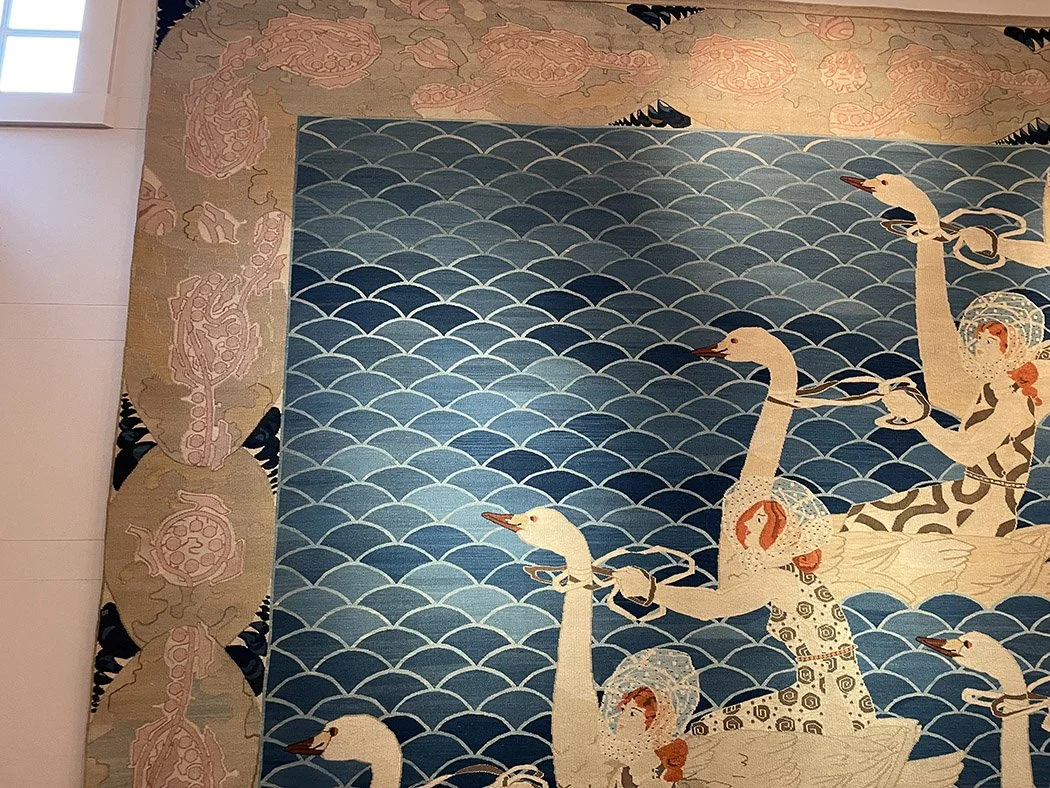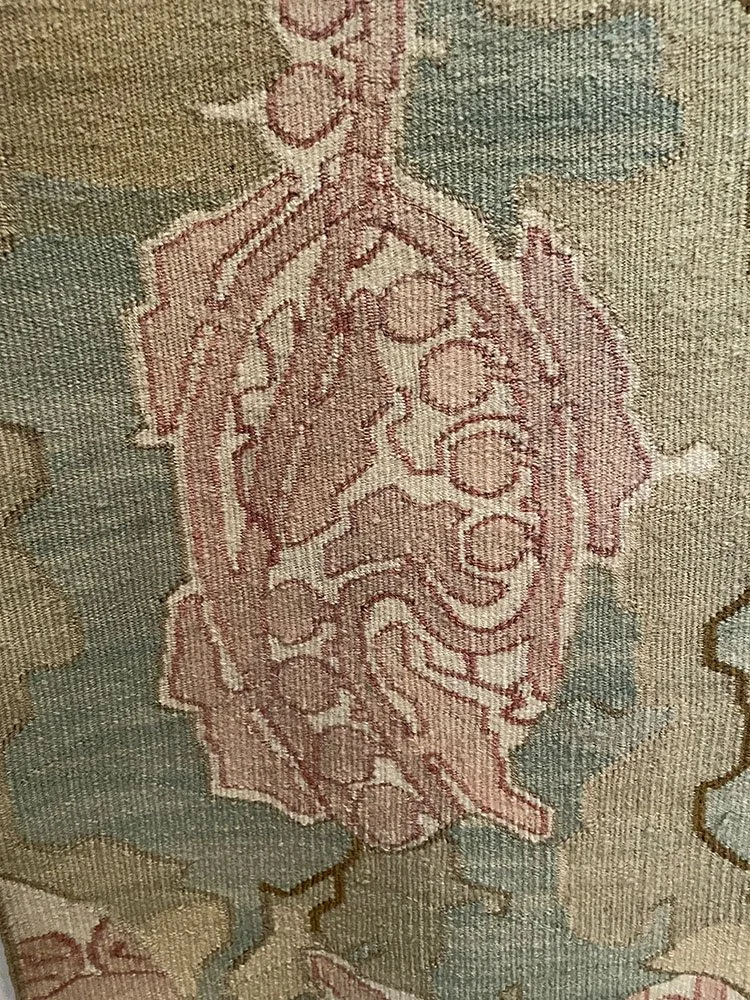Some time before my class at Harrisville Designs in New Hampshire, one of the students in the class, Kerri Keeler, emailed me that she knew about a tapestry just a few miles from our workshop that we should visit. She offered to take care of the logistics and I told her if she could set it up, I would be happy to encourage the group to go.
So Wednesday night during our color retreat, we caravanned to Peter Pap Oriental Rugs to see the lost and now found Frida Hansen tapestry, Sørover.
This is an image-heavy post because I wanted to share the detail shots I took for other tapestry weavers who might not be able to travel to see this piece. It is for sale and once it sells, who knows where it will end up! Keep your fingers crossed for a museum somewhere so the general public can continue to enjoy it.
Here is the group looking at and discussing the tapestry.
Tapestry weavers studying Frida Hansen’s Sørover tapestry at Peter Pap Gallery in Dublin, NH, 2024.
photo courtesy of Carol Nelson, Peter Pap gallery
If you want to know all the things about the tapestry weaver, Frida Hansen, you must read the blogs written by Robbie LaFleur. She writes a personal tapestry blog as well as a blog about Norwegian textiles. I am linking some of those posts along with some lectures she has given at the end of this page.
The mystery of Sørover by Frida Hansen
Not only was this a fascinating tapestry to see in person, it has an incredible story for which I will lean heavily on Robbie LaFleur’s blogs to tell. Here is the full tapestry as it is displayed at Peter Pap.
Frida Hansen, Sørover
Frida Hansen [1855-1931]
Frida Hansen was an artist who worked in weaving and tapestry. She was trained in painting and then ran an embroidery shop. Eventually she decided she wanted to learn to weave in the old Norwegian style. She wove on a warp-weighted loom. In the 1890s she opened a weaving school. She dyed her own yarn and at some point had a dye works.
Robbie LaFleur mentioned in the Vesterheim Museum interview that Frida Hansen was a leader in the fiber art field in that she designed and wove her own work. In Norway at the time, it was usually a male artist who designed the cartoon that was then woven by usually female weavers.
Today in the USA we are more familiar with tapestry weavers designing and weaving their own work, but this isn’t the case throughout history and many workshops still exist that use art created by non-weavers.
Hansen wove many large scale tapestries in the Norwegian billedvev style along with many of her own innovations. She also is known for her wool transparencies which contain open warps. Robbie LaFleur’s blog provides lots of information about these transparencies and she teaches workshops about it.
Sørover [Southward] tapestry
Hansen wove Sørover [Southward] in 1903. It is an image from Norse mythology with ten maidens on swans who are sailing south after bringing sun to the north. The tapestry was brought to America and exhibited widely for a couple decades. And then in 1931 it disappeared for 90 years.
Robbie LaFleur did a lot of research trying to track down the tapestries and she published a blog post about that search in 2018. Then in 2021, the tapestry surfaced. Peter Pap’s friend found the tapestry in a rubbermaid container in a storage building and contacted Robbie after finding her blog post which told him what he had found.
Robbie was able to examine the tapestry closely and noted some of the things we were able to see as well. She says in her talk, “The Mystery of the Missing Swans and Maidens,” that the tapestry was woven in traditional Norwegian Billedvev style and that the ends are all sewn in so the back was as beautiful as the front.
The tapestry was cleaned in Denver, CO by Robert Mann. They needed to remove 120 years of dust. Robbie said that the tapestry was immersed in a large tub they created for it and it needed to be washed three times. More information about the cleaning can be found HERE.
The owner who put the tapestry in the rubbermaid container probably purchased the tapestry around 2010. Where was it before that? It seems that perhaps the first owner, Berthe Aske Bergh did not sell it but passed it onto her son when she died in 1954. Her son Norman died in 1958 in Keene, NH. His wife died three years later in 1961 and their estate was sold at auction. Who bought the tapestry at that auction in 1961? Robbie LaFleur muses about this in her talk for the Vesterheim Museum linked at the bottom of this article. There are more Frida Hansen Swans and Maidens tapestries also still missing. Aren’t tapestry mysteries fascinating?
Maidens and Swans
There are ten maidens and swans (or partial ones) in the tapestry. They’re all different though connected by materials, motifs, and postures. Notice the wonderful transparency in the head scarves!
Frida Hansen, Sørover (detail)
Frida Hansen, Sørover (detail)
The maiden figures all have different styles in their dresses and differing expressions and hairstyles. The roses in the dress below are woven with silver thread which has oxidized over the years to a lovely copper color. I also think these dresses were a bit racy given they were open at the sides!
Frida Hansen, Sørover (detail)
The swans were also marvelous and there is more silver in the ribbons around their necks.
Frida Hansen, Sørover (detail)
Frida Hansen, Sørover (detail)
Frida Hansen, Sørover (detail)
Take a look at the beauty of the water. Robbie postulated in one of her interviews that the blue dye was indigo but it is unknown exactly what kinds of dyes Hansen used.
Frida Hansen, Sørover (detail)
The border
The wide border on the tapestry is fascinating. Robbie LaFleur talks about it some in THIS blog post. The border seems to be all about seaweed which fits the tapestry subject well. Robbie’s post also discusses how the seaweed forms move in and out of the other areas in the border.
The photo below is of the top left corner and gives you a feeling for how intricate this border is.
Frida Hansen, Sørover (detail)
The detail below is from the top right corner and includes Hansen’s signature. I have lightened this photo significantly as the lighting of the tapestry was uneven. Notice the mussels in dark blue that are filling in the triangular areas throughout the tapestry.
Frida Hansen, Sørover (detail)
More border details are below. I believe all of the thin lines throughout the tapestry were accomplished with weft interlocks which would be common in Norwegian billedvev style tapestry. We were allowed to touch the tapestry to look at the back and you can see that double weft interlocks are not being used here.
Frida Hansen, Sørover (detail)
Frida Hansen, Sørover (detail)
Frida Hansen, Sørover (detail)
The image below has some of the border and one of the maidens. You can see those mussel forms right in the middle of the photo. On the right side, see how the seaweed forms with the little circles go under that greenish form? Robbie illustrates this further in her blog post about the border.
Frida Hansen, Sørover (detail)
Notation in the bottom left corner of the tapestry with the dates 1903. I am not sure what DNB stands for.
Update! Susan Ellenbogen writes to say, Enjoyed your article on Frida Hansen and was curious about the "DNB" on her 1903 Sørover tapestry. Looked her up on Wikipedia where I found this: "From 1897 to 1906, Hansen ran Det norske Billedvæveri, a workshop which mainly worked out of her patterns."
Frida Hansen, Sørover (detail)
Thank you to Robbie LaFleur for her research and knowledge about Frida and this tapestry and for sharing it with all of us via lectures and her blog posts. I hope you’re writing a book about this Robbie!
The class members still around when the photo was taken: Rebecca, Kathleen, Sarah, Renee, Kerri, Gail, and Deb
A huge thank you to Peter Pap and Carol Nelson for helping us spend some time with this beautiful tapestry. You can find Peter Pap Oriental Rugs online here: https://peterpap.com/
If you are in Dublin, NH any time soon, please go see this tapestry. Peter Pap is selling it on behalf of the antique dealer’s estate (the rubbermaid storage tub!), so who knows how much longer it will be on public view. If anyone wants to purchase it and donate it to the Vesterheim Museum, that would be a fantastic gift to tapestry weavers everywhere!
Blog posts by Robbie LaFleur about this tapestry and Frida Hansen
Searching Robbie’s blog for “Southward” comes up with a bunch of fascinating articles that you can read HERE.
Mystery of the missing swans and maidens. This is a video of a presentation of a lecture Robbie gave for the Vesterheim museum about this tapestry. The history I gave above was drawn in part from this talk. I highly recommend listening to it if you’re interested in learning more about this gorgeous tapestry.
Robbie gave a talk to the Damascus Fiber Arts school and has linked that video on her blog here: https://robbielafleur.com/2024/07/08/frida-hansen-talks-available-online/




